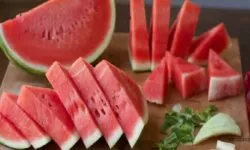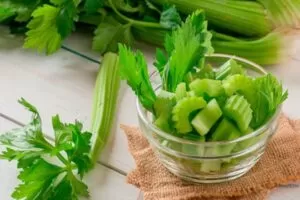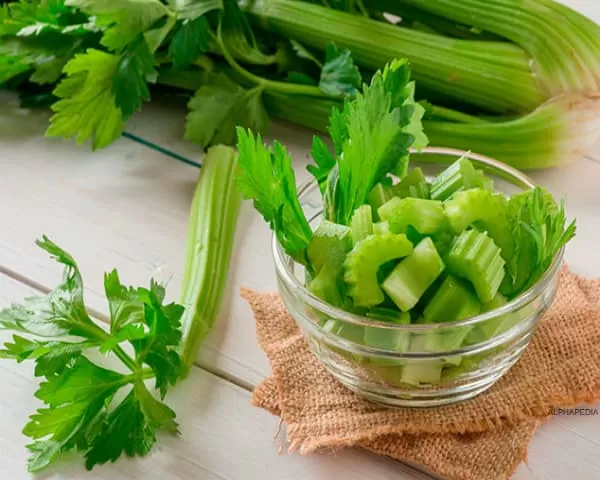Origin of Celery
Celery is believed to have originated in the Mediterranean basin. Ancient literature documents that celery, or a similar vegetable form, was cultivated for medicinal purposes before 850 B.C. It is stated that the medicinal purposes were probably attributed to its volatile oils, contained in all portions, but mainly in the seed. During ancient times, Ayurvedic physicians used celery seeds to treat the following conditions: colds, flu, water retention, poor digestion, various types of arthritis, and diseases of the liver and spleen.
Woven garlands of wild celery have reportedly been found in early Egyptian tombs.
Celery was considered a sacred plant in the classical period in Greece and was used by the winners of the Nemean Games, similar to the use of laurel leaves in the Olympic Games. The Nemean Games were held every two years, beginning in 573, in the small town of Nemea, in southern Greece, on the Poloponnese peninsula. The Romans valued celery more for cooking than for religion, although there was much superstition associated with it. The celery plant was thought to bring bad fortune under certain circumstances. Although celery is believed to have originated in the Mediterranean, indigenous “wild” relatives of celery are found in southern Sweden, the British Isles, Egypt, Algeria, India, China, New Zealand, California, and the southernmost parts of South America. However, it is doubtful that its center of origin was so extensive.
The Italians domesticated celery as a vegetable in the 17th century, resulting in selections with solid stalks. Early stem celery had a tendency to produce hollow stalks.
Properties of Celery
- According to the USDA National Nutrient Database, celery contains minerals such as calcium, magnesium.
- The benefits of magnesium include maintenance of body nerves, muscles and bones, relief of osteoporosis, iron, zinc and potassium.
- It contains fatty acids and vitamins including vitamin A, K, C, E and B vitamins (thiamine, riboflavin, folic acid, vitamin and vitamin B6). It also contains fiber.
Benefits of Celery
The health benefits of celery include the following:
Lowers cholesterol levels
The fiber found in celery can help reduce artery-clogging cholesterol (called LDL or bad cholesterol). The phthalides in these vegetables also stimulate the secretion of bile juices, which work to lower cholesterol levels.
Lowers blood pressure
Celery contains phthalides, which are organic chemical compounds that can reduce the level of stress hormones in the blood. It also contains potassium, which is a vasodilator and helps lower blood pressure. When blood pressure is lowered, it puts less stress on the entire cardiovascular system and reduces the chances of developing atherosclerosis or suffering a heart attack or stroke.
Prevents urinary tract infections
Celery seeds help eliminate uric acid because it is commonly used for its diuretic properties, which means it stimulates urination. Therefore, it is good for people with bladder disorders, kidney problems, cystitis and other similar conditions.
Reduces arthritis pain
Celery is ideal for people suffering from arthritis, rheumatism and gout. It has anti-inflammatory properties that help reduce swelling and pain around the joints.
Anti-cancer properties
Celery contains phthalides, flavonoids such as luteolin and polyacetylenes. Celery also contains coumarins that enhance the activity of certain white blood cells, which can also effectively prevent cancer. These antioxidant compounds scavenge free radicals and neutralize them before they can cause conditions such as cancer.
Boosts the immune system
Rich in vitamin A and C, as well as antioxidants, celery greatly boosts the immune system and makes it more active and efficient. Eating this vitamin C-rich vegetable regularly can reduce the risk of catching the common cold, as well as protect you against a variety of other illnesses.
Reduces asthma symptoms
The vitamin C present in celery prevents free radical damage and also has anti-inflammatory properties that decrease the severity of inflammatory conditions such as asthma.
Improves heart health
The remarkable presence of vitamin C, fiber and other organic chemicals in celery roots promotes cardiovascular health.
Regulates fluid balance
In the typical modern diet, we tend to have too much sodium and not enough potassium, which makes celery well suited to help correct this imbalance. Both of these minerals are important to help regulate fluid balance in the body.
Relieves migraines
The presence of coumarins in celery may provide relief from migraines. The exact mechanism is not fully understood, but research points to a suppression of nitric oxide release in the brain, which can cause headaches and migraines.
Protects the body against oxidative damage.
It acts as an antioxidant, and indeed, you can use all parts of celery, including the seeds, roots and leaves. Eating this vegetable regularly protects your organs from oxidative damage and helps prevent kidney, pancreas, liver and gallbladder disease.
Controls diabetes
Celery leaves are also eaten to treat various diabetic conditions. This is due to its high fiber content, which has been shown to help control diabetic symptoms, according to a study published in the research journal Phytotherapy in 2019.
Prevents cataracts
Dripping celery tea drops on your eyelids is good for certain ophthalmological conditions and can improve eye health, reduce the chances of developing cataracts and protect against macular degeneration.
Weight loss
Regular consumption of celery juice before meals can help reduce your weight. It is very low in calories and is also filling due to its high fiber content. Therefore, it can help reduce the tendency to overeat and keep the weight off without feeling hungry all the time.
Celery Contraindications
Special Precautions and Warnings:
- Pregnancy and Breastfeeding: celery oil and celery seeds are probably not safe when taken by mouth in medicinal amounts during pregnancy.
- Large amounts of celery may cause the uterus to contract and cause miscarriage. There is not enough reliable information on the safety of taking celery oil and seeds if you are breastfeeding.
- Allergies: Celery may cause allergic reactions in people who are sensitive to certain other plants and spices, such as wild carrot, mugwort, birch, and dandelion. This has been called the “celery-carrot-mugwort-spice syndrome”.
- Bleeding disorder: There is concern that celery may increase the risk of bleeding when used in medicinal amounts. Do not use celery if you have a bleeding disorder.
- Kidney problems: do not use celery in medicinal amounts if you have kidney problems. Celery may cause inflammation.
- Low blood pressure: Celery in medicinal amounts may lower blood pressure. If your blood pressure is already low, taking celery may cause it to go too low.
- Surgery: Celery may affect the central nervous system.
There is some concern that celery, in combination with anesthesia and other medications used during and after surgery, may slow down the central nervous system too much. Stop using celery at least 2 weeks before a scheduled surgery.
Celery Recipes
Celery Soda
Ingredients
- 7 – 8 large celery stalks (about 3/4 lb) (plus inner stalks for garnish)
- large lemon
- 1 tablespoon black peppercorns
- 8 green cardamom pods
- 1 1/4 cups water (12 oz)
- 1 cup sugar (7 oz)
- seltzer water (about 2 quarts for the whole batch of syrup)
Directions
- Clean and then thinly slice the celery. It should measure approximately 3 cups when firmly packed in a liquid measuring cup. Set aside.
- Remove the zest in strips from half of the lemon. Lightly crush the peppercorns and cardamom pods. Set aside.
- Bring water and sugar to a boil in a medium saucepan. Once boiling, add the sliced celery and return to a boil for about 1 minute. Stir once or twice in the process. Remove from heat.
- Add the lemon zest, pepper and cardamom to the celery mixture. Stir to combine, then cover the pan and let cool to room temperature.
- Strain the celery syrup through a fine-mesh strainer into a jar or other suitable storage container. Press the celery to extract as much of the syrup as possible.
- Feel free to chop some of the candied celery, it’s surprisingly tasty! (And if you think of any good uses for it, pass them along! I send most of it to the compost pile).
- Squeeze the lemon and add 3 tablespoons of juice to the syrup. Stir to combine. Store covered in the refrigerator until ready to use.
- Mix syrup with seltzer water.
- A dilution of 1 to 4 is a good starting point; adjust to taste. Serve over ice with a tender stalk of celery inside as a garnish if desired.
Another Celery Soup Recipe
Ingredients
- 75 g / 3 oz butter
- 1 tablespoon of olive oil
- 250 g / 10 oz of chopped celery
- 100 g / 4 oz of chopped onion
- 100 g / 4 oz of diced potato
- 1 liter / 2 pints of light chicken / turkey or ham broth
- salt
- black pepper
- heavy or heavy cream
Directions
- Stew celery and onion gently in butter and oil in a covered skillet for 10 minutes. Add the potato and stir to coat well with butter and oil.
- Do not let the vegetables brown. Add the broth. Bring the soup to a boil and then reduce to a simmer for 30 minutes or until the celery is very tender. Blend or pass the soup through a mouli.
- If the celery is particularly stringy, you can pass it through a seive. Taste and add salt and freshly ground black pepper as you think best. Ladle the soup into warm bowls, pour with a little heavy cream, stir and eat.
Green Celery
The long stalks of pale green celery are a good source of vitamins and minerals. Green celery adds crunch to salads and is a quick and easy snack when stuffed with cheese and fresh herbs. In Victoria, celery is at its peak between January and August.
Raw Celery
As long as the celery is rinsed and free of pesticides, yes, it is safe to eat celery raw. In fact, raw celery is very healthy. It contains a good amount of vitamins A, C, K and folic acid, as well as other vitamins and many minerals, especially potassium. It also has a decent amount of fiber. In fact, it has a glycemic load index of 1, which is very low, making it ideal for people with diabetes.
Raw celery also contains negative calories. That is, one cup of raw celery has just over 17 calories, but it takes more than 17 calories to digest it, so a person loses calories by eating raw celery, making it great for dieters. Raw celery has a crunchy texture, making it a perfect addition to salads and soups.
Celery Tuber
It is actually a very ugly, twisted, light brown bulb type root that is very bumpy and resembles a large turnip. Celery root has a distinctive flavor that can be described as a cross between strong celery and parsley with a hint of nuttiness. It has the texture of potatoes.
Celery root or celeriac is grown like celery during the cold season. Although it can be found all winter, it is best in the fall, just after digging it up. Celery roots can range in size from that of an apple to the size of a small melon. It is available in winter. Select firm, hard roots that are the size of baseballs and feel heavy. Often, larger ones have hollows or fibrous cores. If the stems and leaves are attached, they should be fresh and green.
Venezuelan Celery
This is a strain of celery, native to Europe and parts of Asia. It is found growing wild in all temperate zones. It is also known as perilla celery, celery root, and celeriac with turnip root.
The plant is similar to celery, but the main difference between them is that in celery the root develops into a mass that resembles a turnip, is easier to grow and has the characteristic flavor of celery. It is much better for flavoring cooking in general and for eating as a cooked vegetable.
Benefits of Fasting Celery
- Fasting in general has been a growing trend for some time now. It is not so much a program of what you eat as it is a program of when you eat something. It does not follow the traditional 3 meals a day structure.
- Your body is fueled when it processes food. The fed state begins when you start eating and lasts for three to five hours as your body digests and absorbs the food. It is difficult to burn fat when your insulin levels are high, which is what you get when you are fed.
- After that fed state window, your body enters what is known as the post-absorption state, which is just a fancy way of saying that your body is not processing any food.
- The post-absorption state lasts until 8 to 12 hours after your last meal, which is when you begin to enter the fasted state. It is much easier for the body to burn fat while fasting because your insulin levels are low.
- Instead of fasting on water alone, try adding celery, for two reasons. It is 90% water and it burns more calories to process than it provides to the body.
- Celery is a good mental snack. Although it’s basically like chewing water, your mind will think you were eating, and that’s all you’ll need.
- Be prepared to urinate several times per hour after consuming it.
Properties of Cooked Celery
- Unlike some vegetables, celery retains most of its nutrients even when steamed.
- A study published in the journal LWT – Food and Science Technology compared celery that had been steamed, boiled and blanched and found that 10 minutes of steaming allowed the vegetable to retain 83 to 99 percent of its antioxidants.
- On the other hand, boiling and blanching led to a 38 to 41 percent loss of antioxidants.
How to Preserve Celery ?
- To help celery stay crisp and last as long as possible, you’ll want to ditch the plastic bag it came in as soon as it gets home from the store. While convenient, it turns out it’s not the best way to store celery.
- Instead, there are three key elements when it comes to the best way to store celery: keep it whole, wrap it in foil, and store it in the crisper drawer of the refrigerator.
- The vegetable will lose less moisture when kept whole for as long as possible, and the foil should be tight enough so that moisture cannot escape, but not so tight as to wrinkle the stalks.
- Like many other fruits and vegetables, celery naturally releases ethylene gas. When stored in a plastic bag, the gas is trapped and accelerates moisture loss and spoilage.
- Aluminum foil, on the other hand, allows ethylene to escape (while maintaining moisture) and slows spoilage.
- Now, if the celery stalks are already cut, there is a better method of storage. Once cut, the stalks will lose moisture at a faster rate, so it is best to store them in the refrigerator in a sealed container, submerged in water. This keeps the stems hydrated and crisp.
How to prepare celery ?
To prepare celery first:
- You have to clean the celery, cut off the base and leaves, then wash the leaves and stalks under running water. Cut the stalks into pieces of the desired length. If the outside of the celery stalk has fibrous strands, remove them by making a fine cut at one end of the stalk and peeling off the fibers.
- Be sure to use the leaves, as they contain the most vitamin C, calcium and potassium, but use them within a day or two, as they do not store very well.
- Celery should not be kept at room temperature for too long as, due to its high water content, it tends to wilt quickly. If you have wilted celery, sprinkle it with a little water and place it in the refrigerator for several hours where it will regain its crispness.
How to Make Celery Juice ?
Celery Juice Recipe
Making celery juice is really very easy! All you need is fresh celery stalks and a juicer. I recommend buying organic celery if you can, as celery is often sprayed with pesticides. If you have a high speed blender and a bag of nut milk, you can also do it that way.
I included a fresh peeled lime as an optional ingredient in my celery juice. I like how it adds brightness and a little extra flavor. I have also been known to juice an apple with the celery, but that is also optional and increases the sugar content.
How to Make Celery Juice in a Juicer ?
- Grab two bunches of celery and cut off the base and top of the stalks.
- Wash them gently in a strainer.
- Feed the celery through the feed tube of your juicer.
- Serve the juice immediately and store leftovers in a tightly sealed jar in the refrigerator.
How to Make Celery Juice in a High Speed Blender ?
- Grab two bunches of celery and cut off the base and top of the stalks.
- Gently wash them in a strainer.
- Cut the celery stalks into thirds and place them in the base of your high-speed blender.
- Add 1/4 cup water and place the lid on the blender. Blend until smooth, using the tamper to push the celery into the blades if necessary.
- Place a clean nut milk bag over the mouth of a pitcher and pour the blended celery through the nut milk bag. Use your hands to squeeze the celery juice through the bag.
- Serve the juice immediately and store the leftovers in a tightly sealed jar in the refrigerator.
How to Plant and Grow Celery ?
- Celery prefers mild temperatures (warm days and cool nights) and grows best in climates that are not extreme. It is usually grown from seedlings that are planted in partially shaded areas. Celery requires a lot of water.
- Celery is typically harvested four to five months after planting, when the stalks are about 15 cm long.
- You can harvest the entire plant by cutting it at the roots, or you can carefully cut individual stalks. When removing individual stems, it is best to remove the outer stem first, as this allows the younger, inner stems more time to grow.
- Some people “blanch” their celery to reduce bitterness and make the celery more tender.
- The blanching process involves building a pile of mulch to cover the stalks about a month before harvest to prevent light from reaching the stalks. Commercial farmers usually wrap the stalks in black plastic.
- Care should be taken when harvesting celery. Some people develop skin or allergic problems when handling this vegetable, so wearing gloves is a good idea.
Topics Related to Vegetables in ALPHAPEDIA

GARLIC: Properties, Benefits and Contraindications

ZUCCHINI: Properties, Benefits and Characteristics

SWEET POTATO: Properties, Benefits, Origin and History
Health and Wellness Issues at ALPHAPEDIA

FIG: Benefits, Types and Properties

WATERMELON: Benefits, Properties and Contraindications

WINTER FRUITS: Benefits and Properties

BLUEBERRIES: Benefits, Properties and Contraindications

ALMOND: Benefits, Calories and Properties

APRICOT: Properties, Benefits and Their Contraindications
Other Topics of Interest in ALPHAPEDIA

FREE STUDIES IN ARGENTINA: Courses, Diplomas, Bachelor’s Degrees, Master’s Degrees and Doctorates

FREE BACHELOR DEGREE IN GERONTOLOGY

FREE STUDIES IN CANADA: Courses, Diplomas, Bachelor’s Degrees, Master’s Degrees and Doctorates

FREE BUSINESS MANAGEMENT COURSE

FREE ALTITUDE TRAINING COURSE

FREE PRUNING COURSE
Picture and Drawing of Celery



